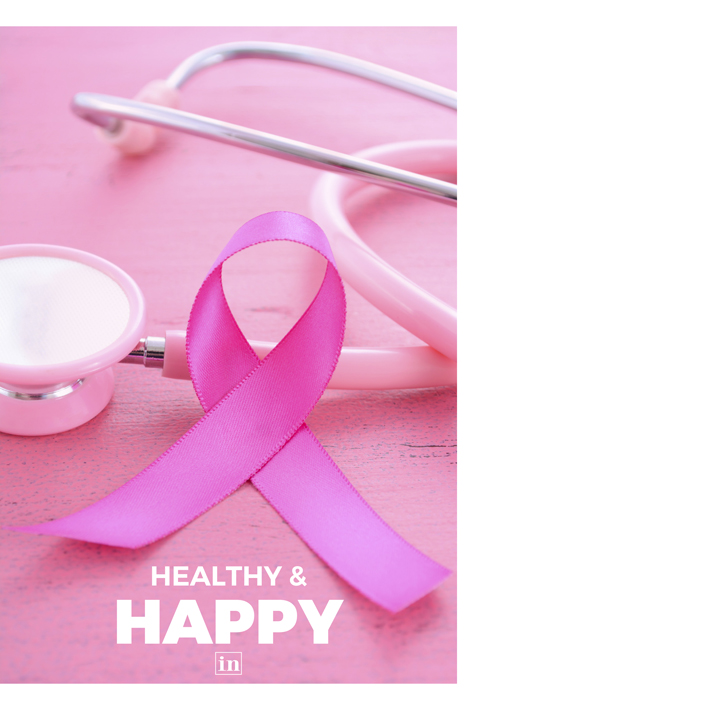HEALTH - HEALTHY & HAPPY
Healthy & Happy
October, 2019 - Issue #181
 courtesy of Shutterstock |
Breast Cancer Awareness
More than 90 percent of women diagnosed with breast cancer have no family history. While a negative family history does not protect you, a stronger familial link to breast cancer, such as the number and age of family members previously diagnosed or a positive finding of certain genetic mutations, the higher your risk.
Age is a strong indicator of who develops breast cancer. In general, the rates of breast cancer are lower in women under the age of 40, begin to increase after the age of 40 and are highest in women over the age of 70. Other risk factors are not having had a child, having had a child after the age of 30, being overweight, early onset of periods before the age of 12, drinking more than one alcoholic drink per day, lack of exercise and higher levels of estrogen in a menopausal woman.
Some healthy lifestyle choices may help lower your risk of the disease while improving your overall health: maintain a healthy weight, exercise 30 minutes four times a week, take a daily vitamin that includes folic acid, limit "bad" fats and consume more "good" fats, including olive and canola oil, increase your intake of fruits and vegetables to nine servings a day and limit alcohol intake.
Regular screening tests can catch breast cancer early when it is most treatable. Monthly breast self-exams (BSE) should be performed by women five to seven days after each menstrual cycle or for women no longer cycling regularly, pick a day of each month to do your BSE. Annual mammograms are recommended for any woman over the age of 40 or earlier depending on individual risk factors or clinical findings. If "dense" breast tissue is noted on the mammogram, an ultrasound may also be ordered. The latest technology is a breast MRI, not a routine study but available for high-risk women and in specific situations of abnormal mammogram findings.
To schedule a breast exam and risk assessment, along with genetic testing if deemed necessary, call Pat News, RNC, NP, MSN of Pat News Health Care. 799-7000
October Health Tip:
The best way to prevent the flu is to get vaccinated in the fall - and wash and dry hands frequently. If you do get sick, remember to cover your nose and mouth when you sneeze - and stay home if you're ill.
Santa Clarita Pharmacy 673-5101
 courtesy of Shutterstock |
Is it Dental Pain - or a Neurological Disorder?
Trigeminal neuralgia is an ongoing pain condition that affects certain nerves in your face. You might also hear it called "tic douloureux." People who have this condition say the pain might feel like an electric shock - and it can sometimes be intense.
To learn about trigeminal neuralgia, it helps to know a little about how the affected nerves are laid out. In your head, you have 12 pairs of what are called cranial nerves. The trigeminal nerves are among these pairs - they let you feel sensations in your face. One nerve runs down each side of your head. Each trigeminal nerve splits into three branches, controlling the feeling for different parts of your face.
Trigeminal neuralgia disorder can affect any of the three nerve branches, meaning you could feel pain from your forehead to your jaw. Usually, you'll feel pain on only one side of your face, though some people feel it on both sides. When that happens, it's called bilateral trigeminal neuralgia. If you have unexplained pain in your face, it could often be falsely attributed to a dental cause - trigeminal neuralgia is much more rare. Concerned you may be dealing with trigeminal neuralgia? Seek the advice of a neurologist.
Advanced Center for Neurology & Headache 888-1099
Invisalign Day at Snow Orthodontics is October 28
A straight, beautiful smile not only builds confidence, it's worth sharing - and during Snow Orthodontics' Invisalign Day, you'll enjoy savings that'll be sure to make you smile. Guests will enjoy a free consultation, free x-rays (A $250 value.), free teeth whitening with Invisalign treatment and down payment matching up to $750 for eligible Invisalign patients.
The clear alternative to braces, Invisalign is the reason over 2 million patients are smiling with confidence. Without brackets or wires, Invisalign takes a modern approach to teeth straightening and is virtually invisible. Using a series of clear, removable aligners, Invisalign gradually moves your teeth toward a smile you've always wanted, making it nearly impossible for others to tell if you're wearing your aligners - unless you tell them!
Invisalign treatment is comfortable to wear and easy to live with. You visit your orthodontist every month or two to check your progression and get new aligners - the average treatment time is about 18 months. Because the aligners are removable, you can continue to eat your favorite foods and brush and floss normally to keep your teeth and gums healthy. Many people incorrectly believe that Invisalign is only effective in treating minor teeth straightening issues, but the fact is that Invisalign successfully treats patients with moderate and severe conditions, including crowding, spacing, overbite, under bite, deep bite, open bite and more.
Dr. Gilbert Snow and Dr. Daniel Azani are Diamond+ Providers of Invisalign, which means they're in the top 1 percent in the world providing Invisalign treatment. Invisalign Day is one day only, from 8am to 5pm - call to learn more. 799-0775
 courtesy of Shutterstock |
Have Venous Reflux?
Help your Legs Look & Feel their Best
People can develop leg pain and varicose veins for many different reasons. Sometimes they are caused by abnormally-functioning veins. The veins in the leg bring the blood from the feet back up to the heart. When walking, the calf muscles activate the venous pump in the leg and promote venous return. There are valves within the vein that allow one-way flow. In many people, however, the veins become enlarged and the valves become incompetent, allowing blood to pool in the legs and ankles. This is called venous reflux. This can cause patients to develop leg pain, especially when standing for long periods of time. In addition, patients may also have leg swelling, itching, cramping, fatigue, heaviness or restless legs. If left long enough, patients can develop permanent skin discoloration or an ulcer near their ankle.
Fortunately, venous reflux can be treated with minimally-invasive procedures that can allow patients to go back to work the next day. Veins with venous reflux can be closed with radiofrequency catheter ablation, which requires just a single needle puncture performed under local anesthesia. Remaining unsightly bulging varicose veins can also be removed under local anesthesia with multiple tiny incisions.
Harvard and Stanford trained, double board-certified surgeon Dr. Larisse Lee focuses on the most-up-to-date techniques to get the results you want. Be it vein treatment, laser liposuction or other concerns, Dr. Lee can tailor a plan for you. Her state-of-the-art facility offers minimally-invasive procedures with exceptional results.
LA Vein Center 818-325-0400
The Impact of Caring for an Aging Loved One
In the US, 65.7 million people provide unpaid care for an aging loved one on a routine basis. From loss of wages to stress-related illnesses and exhaustion, caregiving takes a heavy toll.
Family members often have unrealistic expectations about how much time they will need to spend caregiving and how long it will last. The older the senior, the more hours the caregiver typically contributes. According to AARP and the National Alliance for Caregiving, the average family caregiver spends more than 20 hours per week taking care of a loved one.
Here are some of the challenges the family caregiver faces:
Time management: Competing demands for the family caregiver's time are emotionally and physically exhausting. In addition to working outside the home at least part-time, caregivers also have families of their own.
Loss of work time: Many tasks a senior needs help with often need to occur during the workday, causing the family caregiver to take time off work.
Financial costs of caregiving: Out-of-pocket expenses for aging loved ones are often much higher than planned.
Physical and emotional issues of caregiving: Stress, sadness, anger, frustration and exhaustion are a common reality for family caregivers.
Assisted Living Locators can help you with this caregiving journey. They are a free senior placement and referral service available to Santa Clarita to explore and understand senior living care options, information and resources.
Assisted Living Locators Senior Care Advisor Shannon Avazian 544-1004
Snooze through your Dental Treatments with $100 Off Sedation
There's no shame in feeling fearful of the dentist - it's a common phobia. But now - with the advent of new-and-improved sedation dentistry - there's little excuse to skip essential dental care. Safe, comfortable and convenient, this simple in-office treatment can have you in a twilight sleep during your procedure - and when you book your appointment in October, you can take $100 off the cost of sedation.
Santa Clarita Advanced Dentistry 200-0677
|
||||||||||||||||||||||||||||





